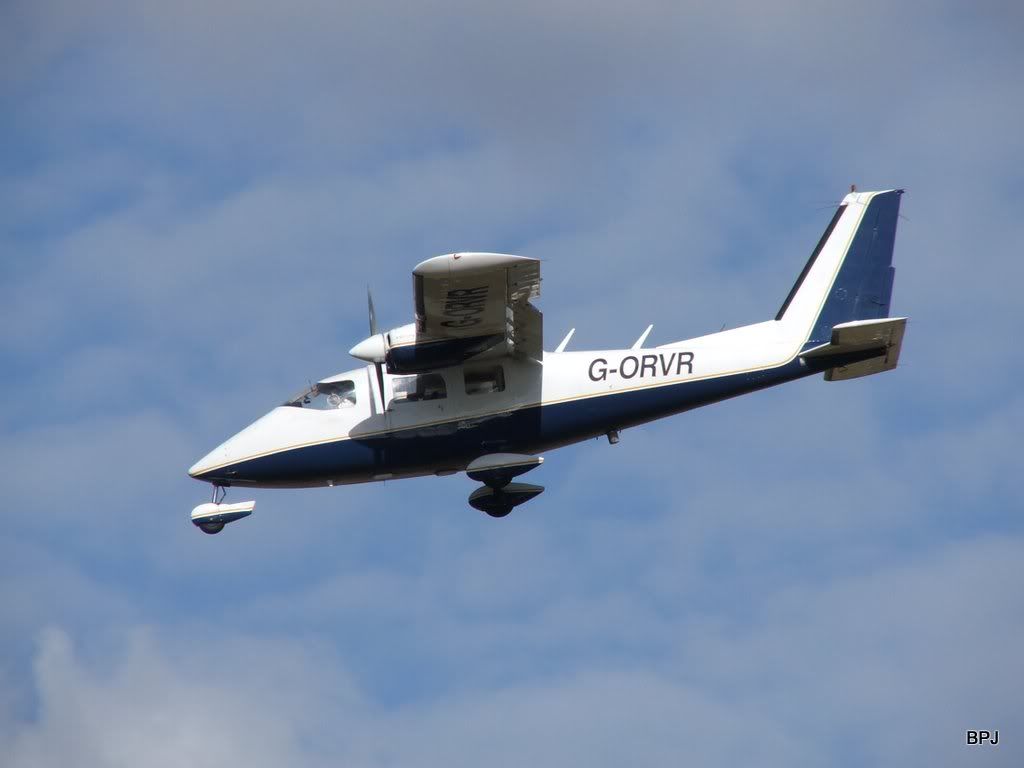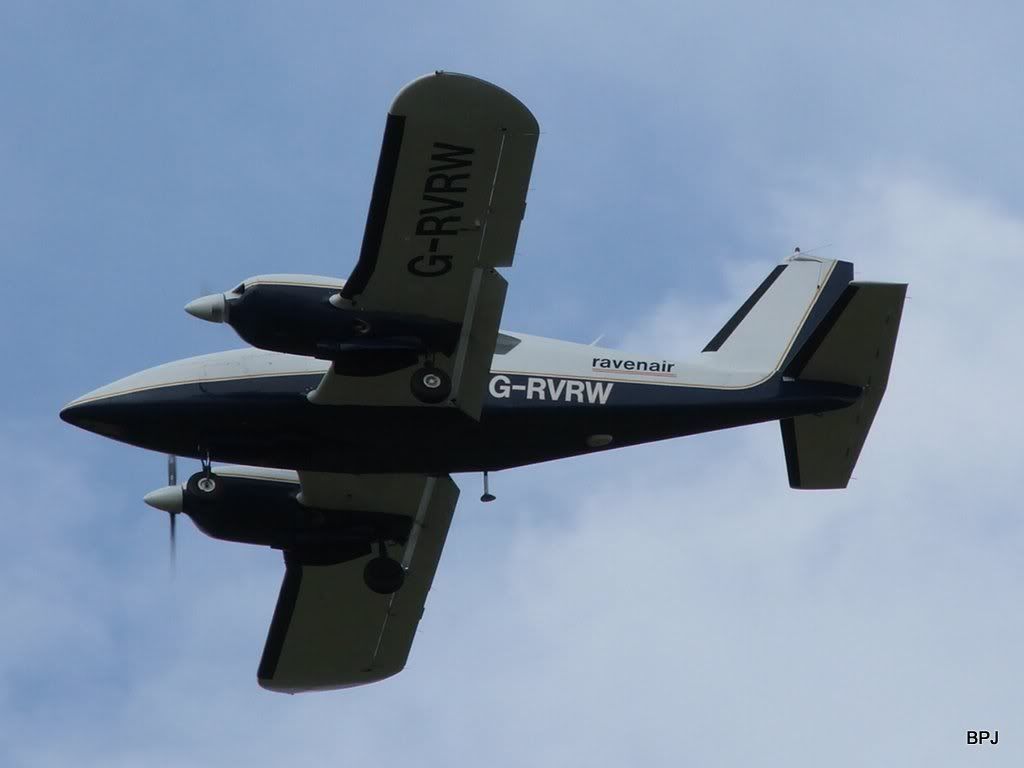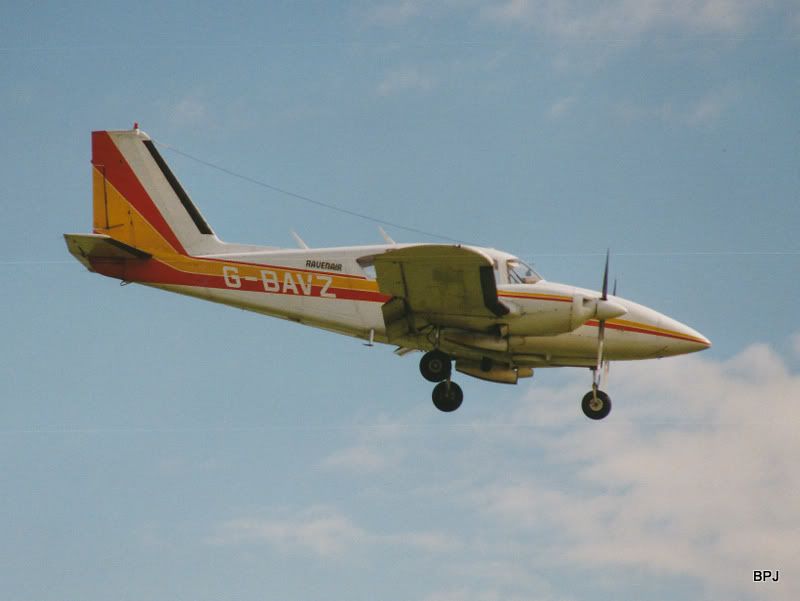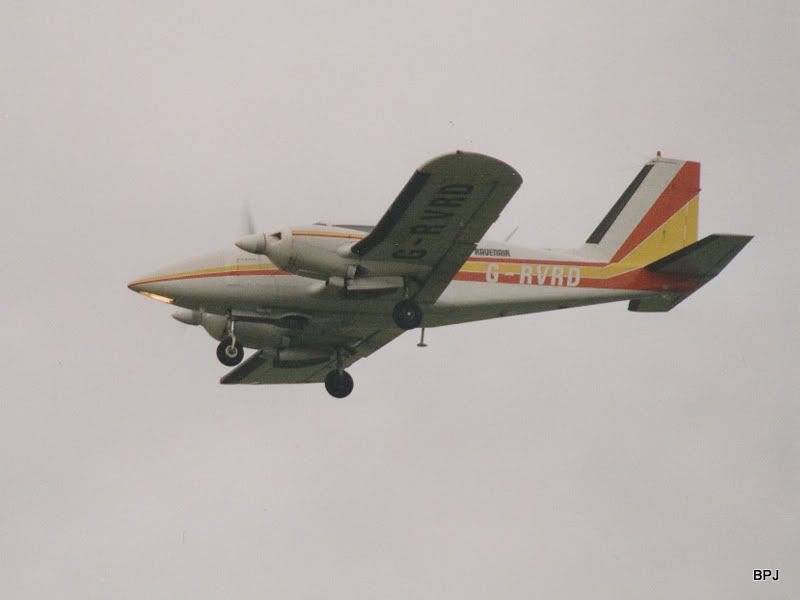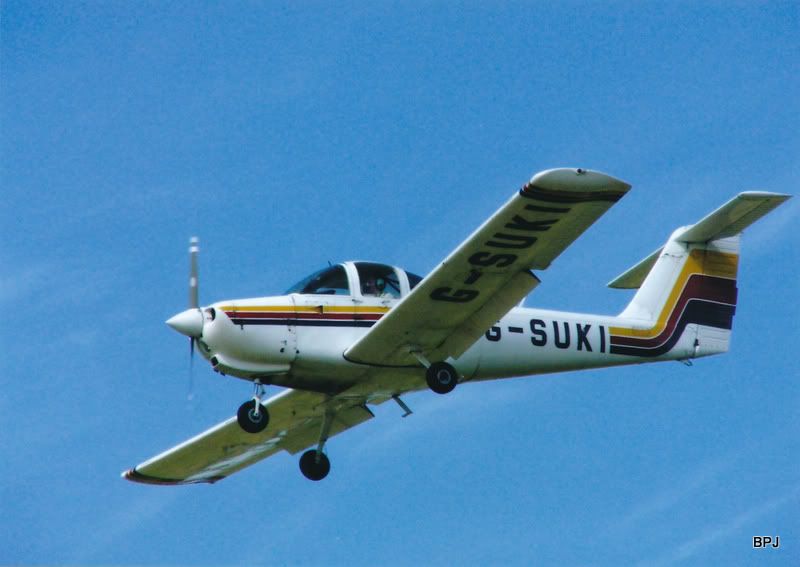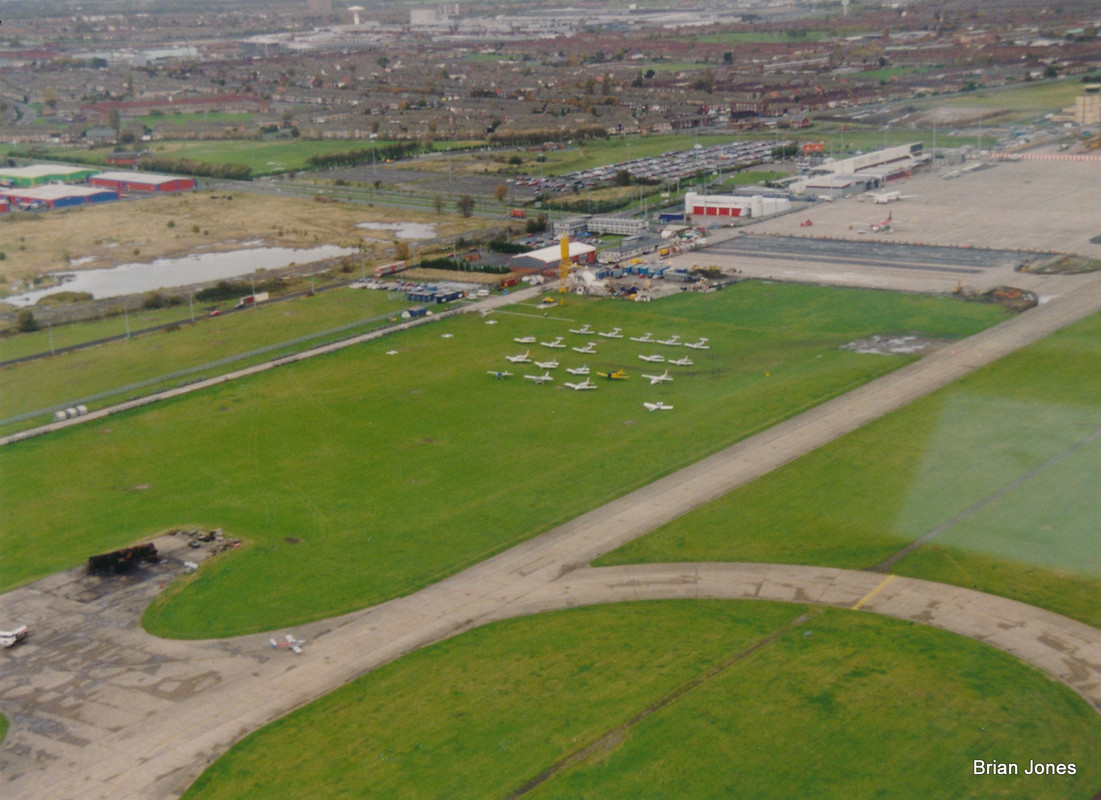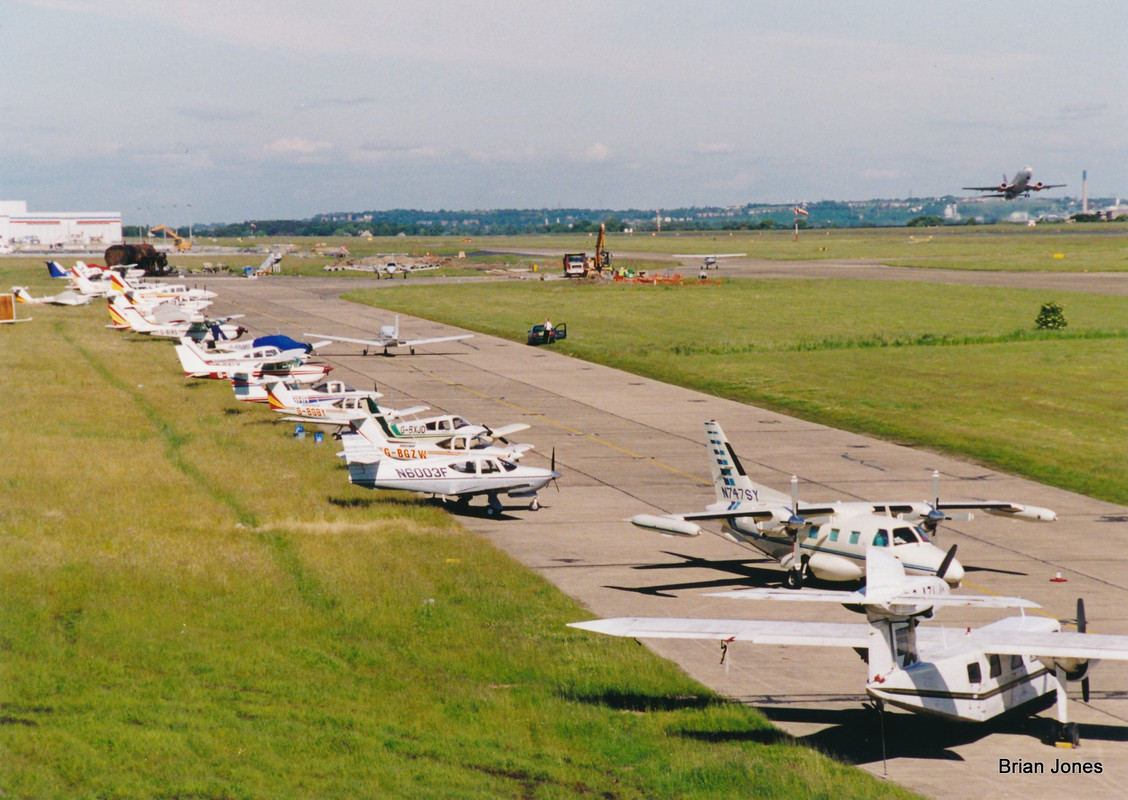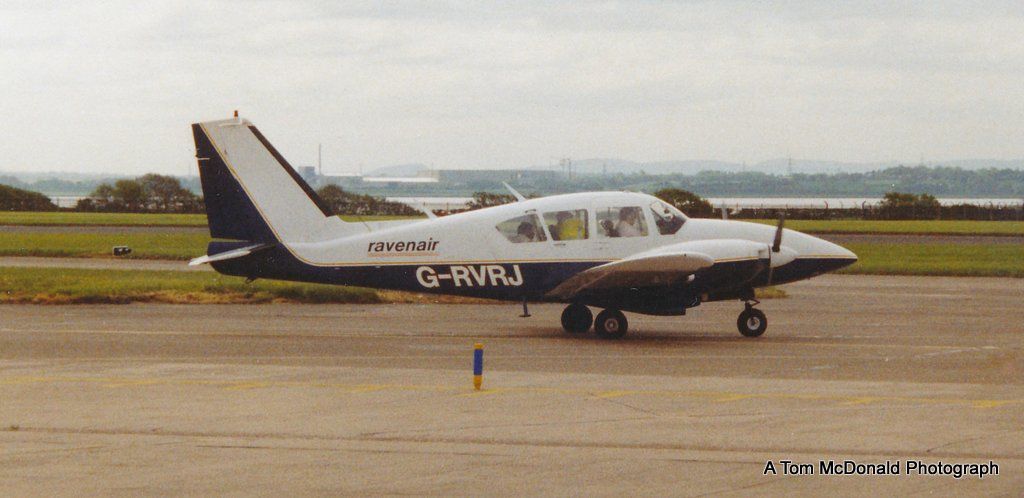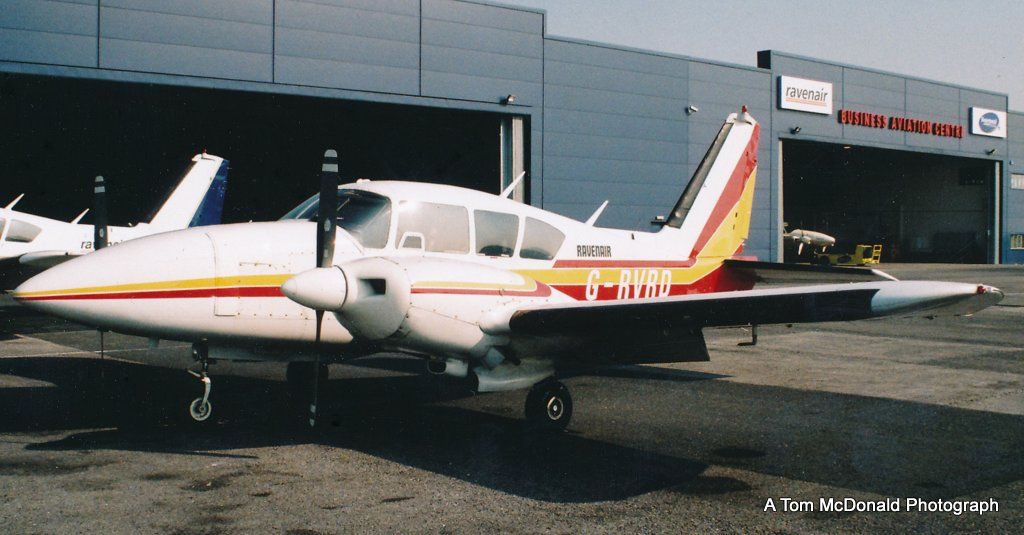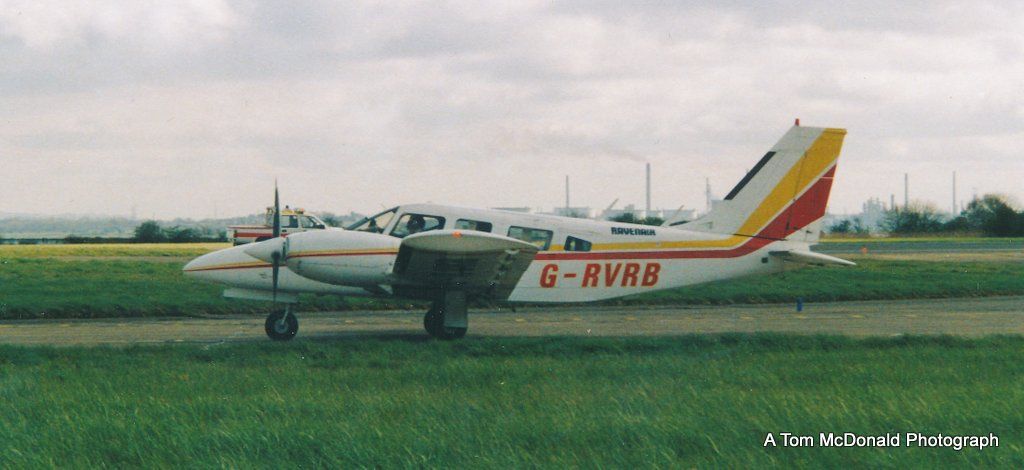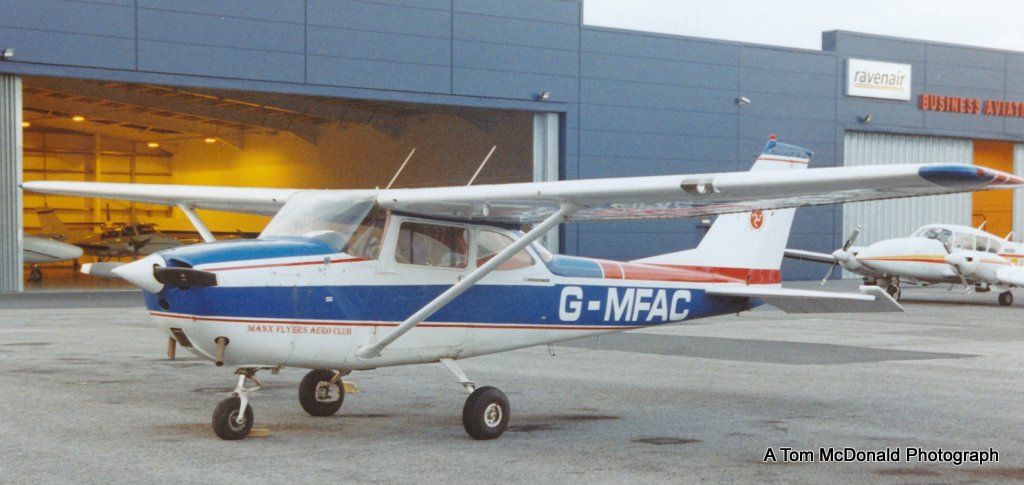Ravenair Operations at Liverpool, 1998-date
Company moves to Liverpool Airport[/b]
The Ravenair fleet transferred across to Liverpool between the 22nd June and 7th July 1998, bringing with them a fleet of 14 aircraft: 7 Tomahawks, a Cherokee, 4 Aztecs, a P.68 and a Seneca, plus other associated private aircraft. This immediately established them as the largest flying school and air charter company at the Airport. Conditions though at Liverpool were somewhat primitive, as the on-going move from north airfield to south airfield resulted in no hangarage or hard apron space being available. At first Ravenair Flying School moved into portacabin accommodation beside a grass apron called ‘Zulu’ to the west of the main apron and terminal. The very wet autumn meant that all the light aircraft moved onto the spur taxiway late ’98, resulting in a less than ideal walk from clubroom to aircraft. There was no cover to permit maintenance, which was totally unsatisfactory for a company with its own maintenance workforce. The Seneca and some of the Aztecs spent much of their time at Manchester Airport still, available for charter work there. Over a year after the move to Liverpool, on 30th September 1999 the general aviation aircraft, including Ravenair’s fleet, moved en masse onto the new tarmac GA apron ‘Kilo’ towards the east, ‘27’ end of the Airport, along with all the portacabin offices and accommodation. While a still far from ideal situation, at least it was a step in the right direction.
From late 1999 it became a requirement that all visiting aircraft to Liverpool Airport required a handling agent. Ravenair, using their experience in the field, established ‘Liverpool Aviation Services’ as a FBO, acting as handling agent for visiting business and general aviation aircraft.
Business Aviation Centre OpensA big step into the future at Liverpool was the announcement in June 2001, after protracted negotiations and delays, that a dedicated £3/4m Business Aviation Centre was to be constructed by Ravenair beside the GA apron. Construction work commenced at the end of July, the new hangar being first used on 18th December 2001, with a ceremonial ‘roll-in’ of an AD Aviation Citation. The new hangar also provided a VIP handling lounge, offices for Liverpool Aviation Services, and an Operations Centre for Ravenair Charter. The new business centre immediately attracted Cessna Citation operator, AD Aviation, and other biz-jet operators to base their aircraft with Ravenair. Also, Ravenair could now re-establish its maintenance operation in its own heated hangar. The whole company went through an impressive transformation, right down to revamping their websites.
There were few changes to the fleet in the difficult first three and a half years at Liverpool. Tomahawk G-BGSI was damaged in an incident at Sleap, December 2000 and reduced to spares, while Cherokee G-RVRA had an accident at Welshpool September 2001 and was sold as a rebuild project without returning to Liverpool. In May 2002 the Cherokee was replaced by another in the form of Warrior G-BPID. At the end of 2002 the fleet was still much as when the company arrived at Liverpool, with 6 Tomahawks, a Cherokee, 4 Aztecs, a P.68, and a Seneca which continued to spend much of its time at Manchester.
Company GrowthWith proper accommodation, Ravenair began to thrive at Liverpool. Three aircraft were added to the fleet during 2003, Cherokee G-AYKX in April, Seneca G-VVBK in July and Partenavia P.68B D-GIFR in November, which quickly became G-RVRE before entering service. In 2004 a third Partenavia, G-PART arrived in November. With their own maintenance now well established at Liverpool, Ravenair began the process of smartening-up the corporate image of the fleet. While still at Manchester, in 1997 and 1998, seven of the fleet had been re-registered in the G-RVR* sequence, reflecting Ravenair’s abbreviated name. Late in 2004 this process of overhaul, paint stripping, repaint (usually at Sleap) and re-registration using corporate colours (yellow and orange cheats for the singles, blue underside and rudder, white top for the twins), with several aircraft so treated every subsequent year. The scheme on the twins was attractively revised, starting with G-RVRX in April 2010.
Ravenair, during 2004 further established itself as the leading general aviation operator and training school at the airport with the opening of a second hangar, completed in early August. This second phase of development cost around £950,000 and clearly showed the company’s continued commitment to the airport. Associated ground handling agent, Liverpool Aviation Services, continued to operate as Liverpool’s Fixed Base operator serving GA visitors and business charter flights; with their VIP facilities and a conference suite putting them at the forefront of activity on the GA apron.
One unusual activity in June 2005 was to play as host to a corporate day organised for customers of David M Robinson jewellers which also involved the Breitling Display Team with their six L-39 Albatroz aircraft.
Expansion Continues At the very end of 2004, Manx Flyers Aero Club, based at Ronaldsway, on the Isle of Man was acquired, along with their two Cessna 172H aircraft G-CCCC and G-MFAC, and continues to be operated as a Ravenair company. So, 2005 saw not only the acquisition of the MFAC’s 2 Cessna 172s, but further expansion of the Flying School business brought in 6 additional Tomahawks: G-BMML in February, G-SUKI & G-BTJK in July, G-BTND & G-BOUD in September and G-BTAS in October along with a fourth Partenavia P.68B G-SAMJ in November. Only departure from the fleet was Aztec 250E G-RVRC sold to a local owner early in 2005. Some of the 2005 fleet expansion was due to establishing a flying school operation at Barton Aerodrome, with a number of Tomahawks based there to take advantage of the less restricted airspace. Indeed Tomahawk G-RVRO has oversized low pressure tyres fitted, adapting it ‘Alaskan’ style to grass runway operation. The Tomahawk fleet increased again in 2006 with G-BRHT and G-DFLY during August, while on the negative side G-BMML was damaged in an take-off incident at Barton during September and returned dismantled to Liverpool for parts recovery. Until 2006 all the aircraft had been registered to ‘Cheshire Flying Services Ltd’, however in June with an internal company reorganisation, the registered ownership of the whole fleet was transferred to ‘Ravenair Ltd’.
There were fewer fleet changes during the following years as the new operations at Barton and Ronaldsway became fully established. During May 2007 the resident maintenance operation at Barton was acquired by Ravenair to work on their own Tomahawks, Cherokees and on privately owned light aircraft. Charter and contract flying using the Partenavias and Senecas continued apace from Liverpool. LAS and Ravenair added the Lear Jet to their AOC portfolio with three Lear Jet 45s, G-JANV, G-SOVB and G-SOVC being managed by the company for a while, in addition to the three AD Aviation Citations and G-JETJ. A further Tomahawk G-NCFE was acquired in November 2008 as a replacement for G-RVRG damaged in a landing incident at Barton in July. A fifth Partenavia P.68B G-HUBB arrived in October 2009, while both of the former MFAC Cessna 172Hs, were sold. Although now a fairly elderly type, an additional Aztec, G-NRSC was acquired in April 2010, by the end of the year repainted and registered G-RVRZ. With all possible registrations in the G-RVR* sequence used, the next re-registered aircraft began the G-RVN* sequence, reflecting Ravenair’s call-sign “Raven”. By November 2011 the gradual process of repainting all the Cherokee and Tomahawk ‘singles’ aircraft into fleet ‘house’ colours was completed when G-BTAS, now G-RVND re-joined the fleet, comprising of 12 Tomahawks and 2 Cherokees. November 2011 also saw two new arrivals, with Partenavia P.28B G-BMOI and Aztec 250 G-TAPE, although the Aztec was acquired for spare parts rather than for flying operations.
Around twice a year a Ravenair symposium for want-to-be pilots is held at the Liverpool facilties, where potential students are introduced to the company, the aircraft and what is involved in learning to fly from start to gaining commercial pilot qualifications.
Following a review into the commercial viability of continued operation from City Airport/Barton with rising costs and a reduction in business, during May 2011 notice was handed into the management at Barton, that Ravenair would vacate their premises, club rooms and maintenance hangar by 31st July. Tragically, in the closing days of operation, Tomahawk G-RVRF following take-off, came down just outside the aerodrome at Barton, hitting a house and bursting into flames. The two occupants being severely injured, the pilot subsequently dying in hospital. The first fatal flying accident in over thirty years of operation, this came as quite a shock throughout the whole company.
Ravenair TodayWith thirty years of operating experience, Ravenair in 2011 offers a wide range of facilities and services, with flight training, air charter, aerial survey, aircraft handling and aircraft management along with hangarage and engineering. The company founder, Jeff Nuttall is Managing Director and Head of Training; Wayne Barrett is Operations Director covering all areas of business, Steve Barker is Operations Manager with a particular responsibility for charter and LAS activities; while Neil Bishop is Quality Manager – an increasingly important role with the increasing influence of EASA in the legislative and regulatory role. The Chief Flying Instructor (CFI) is Martin Hatton, with responsibility for both basic and advanced training activities. In October 2011 the company had 73 people on the payroll, making Ravenair a significant employer in South Liverpool. Along with the Managers named, full time staff include 7 with the flying school, 10 in engineering, 7 AOC charter pilots, 6 in Operations, 6 in Admin/accounts, the remainder being part time or free-lance employees.
Since August '11, the Flying school has operated 14 single-engined aircraft (12 Tomahawks and 2 Cherokees) and holds more CAA and EASA training approvals than any other North West organisation, offering Private Pilot’s Licence (PPL), National Private Pilot’s Licence (NPPL), Commercial Pilot’s Licence (CPL), Flight Instructors Course (QFI), Instrument Meteorological Conditions Rating (IMC), Night Rating (NR), Multi-engined rating (MER) and Instrument Rating (IR). Ravenair Air Training has bases at Liverpool and the Isle of Man (Manx Flyers with two Tomahawks in use).
Following new arrivals during November '11, February '12, March '12, February '13, March and April '13 for air charter and air survey, Ravenair now operate a fleet of 14 twin-engined piston aircraft (4 Aztec, 2 Seneca and 11 Partenavias), all are operated under the approval of the company’s EU-OPS-1, Air Operators Certificate. Indeed in May '13 the company owns 11 of the 22 Partenavia P.68 aircraft on the British register, as they have proved very capable in the aerial survey role. The aircraft are multi-role, flying passengers, light freight, aerial survey, human organs and airline aircraft-on-ground (AOG) spares. The aircraft are available for charter 24 hours, enabling the ultimate in flexible timetabling and a secure, private environment all the way from check-in at Ravenair’s own Business Aviation Centre. Rapid response charter not only involves people, but also time-critical transplant organs, oil industry components, car parts, digital media and urgent documents which can all be carried quickly and cost-effectively. There is an increasing emphasis on aerial survey contract work which includes pipeline inspection, photography, wildlife monitoring around proposed locations for wind farms. Three of the Aztecs and all the Partenavias are modified with camera ports for cameras and environmental monitoring equipment to be fitted, while one of the Partenavias is the Observer version with much increased pilot vision. With some survey flights exceeding 7 hours duration, they represent quite a challenge to the crew comprising of pilot and camera operator. With digital processing, there has been a rapid change to the use of cameras for data recording, rather than using observers.
On behalf of the business owner, Ravenair offers aircraft management services, including organising and training crew, management and maintenance scheduling, flight planning along with slots and permissions, catering and cleaning, insurance and legal advice. The Business Aviation Centre provides VIP check-in, with facilities for Customs, Immigration and Special Branch clearance.
Liverpool Aviation Services is the only handling agent at Liverpool dedicated to business and general aviation. LAS can supply both Avgas 100LL and Jet A1 fuel for airline, business and GA flights, with its own 3 tankers and 2 fuel trailers operating from the fuel farm on behalf of Shell.
Ravenair Maintenance holds EASA Part 145 licence approvals for line and base maintenance on single and multi-engine piston and turboprop aircraft along with Cessna Citation 500 -560XL and 650 business jet types and holds Cayman and US FAA ‘A&P’ engineering approvals.
For more on the scope of current operations visit their websites
www.ravenair.com and
www.liverpoolhandling.co.ukThanks to NWAN magazine, especially Paul Tomlin’s article in 1998 and Dave Graham’s annual summary on nwan.co.uk along with caa.co.uk/GINFO. This review put together by Brian Jones for nwan forum composed October 2011 and updated February 2013. Thanks to, to Jeff Nuttall of Ravenair for approving and adding to the original draft. 









